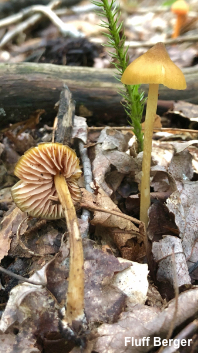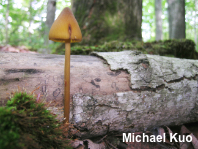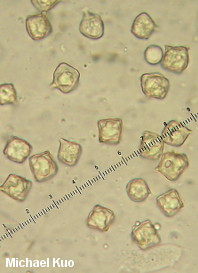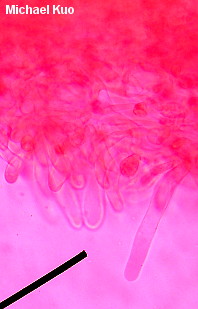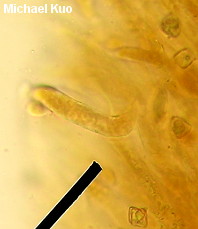| Major Groups > Gilled Mushrooms > Pink-Spored > Entolomatoid Mushrooms > Entoloma luteum |

|
Entoloma luteum [Basidiomycota > Agaricales > Entolomataceae > Entoloma . . . ] by Michael Kuo Entoloma luteum is like the drab, dreary little brother of Entoloma quadratum and Entoloma murrayi, both of which are brightly colored. Unlike its siblings, Entoloma luteum is a dull brownish yellow—and its cap is not as acutely conic. It is found in hardwood and mixed hardwood-conifer forests, often near moss, in eastern North America. Under the microscope it features cube-shaped spores and long cheilocystidia. Rhodophyllus luteus and Inocephalus luteus are synonyms. Thanks to Fluff Berger for collecting, documenting, and preserving Entoloma luteum for study; her collection is deposited in The Herbarium of Michael Kuo. Description: Ecology: Saprobic; growing alone, scattered, or in little clusters under hardwoods or mixed hardwoods and conifers; summer and fall; probably fairly widely distributed east of the Great Plains. The illustrated and described collections are from Michigan and Pennsylvania. Cap: 1–3 cm; rounded-conical or bell-shaped; dry; bald, or finely silky over the center; dull brownish yellow, occasionally with a greenish tinge; fading to dull yellowish; the margin becoming finely lined. Gills: Narrowly attached to the stem; nearly distant; at first whitish or yellowish, becoming brownish pink with maturity. Stem: 3–6 cm long; 2–4 mm thick; more or less equal; dry; bald or very finely hairy; whitish near the apex, elsewhere colored like the cap; basal mycelium white. Flesh: Thin; fragile; yellowish. Odor: Not distinctive. Spore Print: Pink. Microscopic Features: Spores 8–12 µm; cuboid; smooth; walls about 0.5 µm thick; hyaline to yellowish, often with one large oil droplet, in KOH. Basidia 4-sterigmate. Pleurocystidia not found. Cheilocystidia 50–100+ x 10–15 µm; cylindric with rounded or clavate apices. Pileipellis a cutis with frequently uplifted terminal elements; golden in 10% ammonia; pigment granular and intracellular. Clamp connections present. REFERENCES: Peck, 1902. (Saccardo, 1905; AH Smith, 1953; Hesler, 1967; Horak, 1976; Barron, 1999; Roody, 2003; McNeil, 2006; Baroni, 2017.) Herb. Kuo 09110409, 08191901. This site contains no information about the edibility or toxicity of mushrooms. |
© MushroomExpert.Com |
|
Cite this page as: Kuo, M. (2019, September). Entoloma luteum. Retrieved from the MushroomExpert.Com Web site: http://www.mushroomexpert.com/entoloma_luteum.html |
